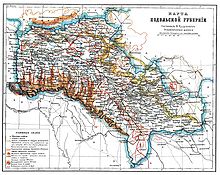Podolia

Podolia ( Ukrainian Поділля Podillja , Polish Podole , Russian Подолье Podolje , Romanian Podolia ) is a historical area in southwestern Ukraine and in the northeastern part of Moldova (here the northern half of Transnistria ).
geography
The landscape of Podolia, which is part of the great Eastern European Plain east of the Carpathian Mountains , is characterized by agriculture. In the Podolian Plateau it is flat to hilly and crossed by canyon-like river valleys. The most important rivers are the Sbruch , the Southern Bug and the Dniester , the larger cities of Vinnytsia and Khmelnytskyi in the east and Kamianets-Podilskyj and Ternopil in the west.
etymology
Podolia goes back to the Slavic root dol- , which means valley or lowland (cf. Doline ). The prefix po- means roughly at or along . The landscape names Pomerania , Pomorje , Pokutia , Polesia and Podlachia are structured according to a similar principle .
history
In ancient times Scythians and Sarmatians lived in Podolia . The Tyragetes, a Thracian tribe, lived along the Dniester River . In the 5th to 6th centuries, Slavs poured in from the north. The area was later crossed by the Huns, Avars, Magyars and Mongols.
After the turn of the millennium, Podolia belonged to the Ruthenian principality of Halych-Volhynia , from 1366 to the Second Partition of Poland (1793) to Poland-Lithuania .
During the numerous battles against the Tatars of the Ottoman Empire in the years 1530 to 1550, the Silesian Bernhard von Prittwitz († 1561) distinguished himself as Terror Tartarorum ("the terror of the Tatars"), who was given the office for this by the Polish crown of the Starost of Bar and Trembowla (today: Terebowlja) and numerous estates was rewarded. Nevertheless, a large part of Podolia fell to the Ottomans in 1672 during the Ottoman-Polish War (1672–1676) (see Islam in Ukraine ). Only after the war in Hungary , when the Polish King John III. Sobieski had successfully participated in 1683 (see Siege of Vienna ), Podolia came back to Poland in 1699.
Under Polish rule, the area was administered in the form of the Podolia and Bracław Voivodeships . Kamjanez-Podilskyj (Polish: Kamieniec Podolski ) was the south-eastern border fortress of the Kingdom of Poland for centuries.
In 1793 part of the area became part of the Russian Empire (in 1772 the western parts were integrated into Austrian Galicia ) and there formed the governorate of Podolia . Between 1813 and 1835 there was a peasant uprising in Podolia led by Ustym Karmaljuk . From 1920 to 1939 the western part of the area belonged to Poland, the eastern part to the Soviet Union (Ukraine and Moldova).
Podolia in literature
The writer and journalist Soma Morgenstern from Budzanów , Eastern Galicia , chose Podolia in his great novel, the Trilogy Funken am Abgrund , as the setting for the novel, in which a young man of Jewish origin who grew up in an assimilated environment in Vienna can see the meaning of Jewish existence for himself discovered and found his way back to the faith of his people.
Today's affiliation
Today's oblasts Ternopil (eastern part), Vinnytsia and Khmelnitsky are located in the area of historical Podolia . A tiny part in the southeast belongs to the Republic of Moldova (the north of Transnistria , with the cities of Rîbnița and Camenca ).
See also
- Bessarabia
- Budschak
- Bucovina
- Galicia
- Tauria
- Volhynia
- List of German names of Ukrainian places
- History of Ukraine
Web links
Individual evidence
- ^ The trilogy of novels Funken im Abgrund , Verlag zu Klampen, Lüneburg 1996, Volume I: The son of the prodigal son, ISBN 3-924245-38-X ; Volume II: Idyll in Exile, ISBN 3-924245-39-8 ; Volume III: The Legacy of the Prodigal Son; ISBN 3-924245-40-1

